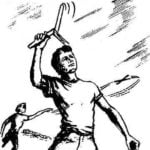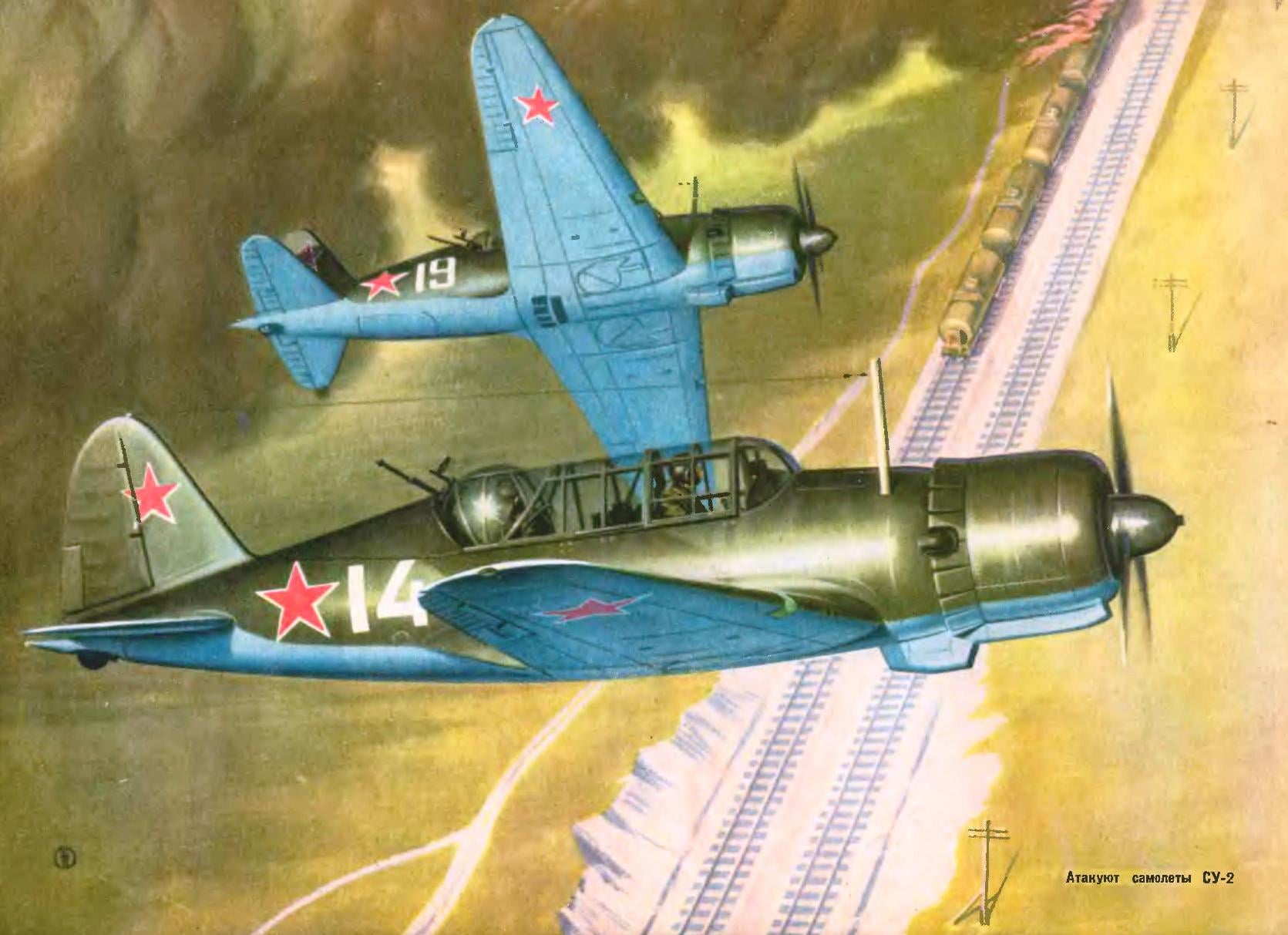 In 1936 the staff of A. N. Tupolev was given the task to design and build a new double multi-purpose aircraft. The implementation of this task was entrusted to the team of Pavel Osipovich Sukhoi, which has previously proven itself as a aircraft ANT-25, ANT-37 (“homeland”) and many others. In August, the aircraft, designated ANT-51 (S-3) was ready for testing. When the lapping machine emerged that can significantly improve its flight and tactical quality. First, the aircraft was equipped with engine M-62 with a capacity of 20 HP, and in 1939 for mass production was adopted the variant with the motor M-68 with a capacity of 1,000 HP, yet it was later replaced by M-82 with a capacity of 1440 HP Respectively grew the speed of the aircraft, increased its armament.
In 1936 the staff of A. N. Tupolev was given the task to design and build a new double multi-purpose aircraft. The implementation of this task was entrusted to the team of Pavel Osipovich Sukhoi, which has previously proven itself as a aircraft ANT-25, ANT-37 (“homeland”) and many others. In August, the aircraft, designated ANT-51 (S-3) was ready for testing. When the lapping machine emerged that can significantly improve its flight and tactical quality. First, the aircraft was equipped with engine M-62 with a capacity of 20 HP, and in 1939 for mass production was adopted the variant with the motor M-68 with a capacity of 1,000 HP, yet it was later replaced by M-82 with a capacity of 1440 HP Respectively grew the speed of the aircraft, increased its armament.
On the basis of the model was constructed a few modifications. As of the middle of the bomber (BB-1) su-2 was widely used during the first period of the great Patriotic war, and its serial production continued until the autumn of 1942. In the future, the team of P. O. Sukhoi developed the idea of multi-purpose plane: there were armored su-6.
The su-2 is a double cantilever monoplane with low wing and retractable landing gear. The design combined the fuselage, and the keel is wooden, the other elements are metal.
A fuselage of type “monocoque” with base trim, solid wood, set of 20 frames connected by four spars and stringers, and plywood sheathing (shell).
The front plateau is used for fastening the turret. Installed the front brackets, they fit two of the strut, forming chetyrehstennoy pyramid, which protects the crew when nosing.
Rear sloping plateau located directly behind the front. Over it is placed rear foldable fairing.
Rear hatch provided in case of an accident. Through it can bail out the Navigator. The hatch is a sheet of aluminum, curved form of the fuselage, with the corners of the rigidity of the contour. At the rear of the hatch riveted two hinges.
The lantern has a convex streamlined visor of Plexiglas. The cockpit closes high light, movable part of which is from the left side of the window, shifting back on the rails. Behind the pilot’s head is a fixed light with rear slanting cut at the lower ends of the visor. When fired he deflected the gun barrel forward and upward and returns to its original position by the springs mounted on the front of the plateau. The visor can be rejected to the rejection forward and locked in this position by the lock’ then the Navigator is easier to enter the cabin and open the screen the turret.
Retractable rear fairing when using the turret can be lowered to increase the angle of fire. The middle part of the fairing is hinged on the bulkhead of the fuselage in front of the keel. Sinking down, she pulls the two side pieces, rotating around the hinges, which are located on the sloping plateau on converging axes.
The tail fairing has a cutout for the spike wheel, and at the end it is attached to the tail lamp of fire. The plane is grounded using a metal chain that attaches to the plug spike wheel stored in the rear fairing
The wing is a cantilever design consists of a center section, tightly attached, and the fuselage and consoles. Wing profile-type kV” with a relative thickness on the axis of symmetry — 17,6%, on the axis of the connector is 15.25% and 8% at the end. The junction of the center section and consoles closed dural ribbon, fastened with screws. The wing has a transverse “V” and on the bottom surface is stored on the center.
The center section trimmed with smooth sheets of aluminum. Riveting plating to wear to the first longitudinal member and between the first and second side members is performed on top of a studded flat hat wpoty. The rest of the lining — rivets with lenticular head. The fairing between the wing and the fuselage is bolted and reinforced membranes. At the trailing edge of the wing are located the flaps of the two halves deflected 55°. Under the fuselage in shields made of plexiglass Windows for visibility from the cockpit of the Navigator. Bomb Bay closed by two shutters made of aluminum
Wing (same as the center section) covered with dural sheets. Blind rivet trim at the toe and top to the second spar — rivets wpoty, everything else — rivets with lenticular head. On consoles of the wing is made cutouts for the headlamps at a distance of 3200 mm from the axis of the aircraft. The toe of the Aileron is covered with fabric. The ailerons are deflected at 25° down and up, on the left has operated trimmer. The flaps of the wing is covered with sheet duralumin, are hydraulically driven and are deflected by 55°.
Stabilizer — cantilever, with a symmetrical profile, one-piece construction, sheathed in the dural leaves the Installation angle of 0.5°. The connection to the fuselage is covered by a small fairing
Handlebar height with axial compensation, for each half installed trimmers. The nose part covered with duralumin, the steering wheel is swathed in cloth.
Keel — same design as the wheel height. Trimmers rudder height and made of duralumin. The chassis is retracted into the space between the spars of the wing. The wheels have a size of 750 X 250 mm and equipped with brakes. The surface of the protector is smooth, without a pattern. Wheels, landing gear and side struts in the retracted position the flaps are closed.
Spike wheel is a steerable, retractable in-flight populallon size 300X125 mm without protector. The mechanism of spike device provides for a variance of 42° to the right and left on the ground and the locking forks in the neutral position when the separation of the tail from earth.
The outer hood is structurally designed in the form of three removable panels inserted into the groove of V-shaped profiles which are fixed on the motor. Hood cinch t-profiles that are at the front end of the bracket, and on the back is a special tension lock. Because of the large size covers sheets reinforced with transverse profiles roughly in the middle and near the trailing edge. On the lower cover tunnel is a suction pipe of the carb, near the front edge of the hood.
The skirt of the hood is divided into three sectors, which are bonded to each other at places of contact of the covers. Two side sector each have six wings, and the bottom four. Sash, in addition to the hinge, the associated guide plate of stainless steel. When the skirt is fully opened, this leaf keeps its shape, overlapping the gap between the doors. Hinge pivot common to the two folds is located between and attached to the ring skirt. In the right lateral sector has cut out two leaves for the exit pipe of the exhaust manifold.
Spinner consists of two parts, connected by bolts. In the front part riveted steel ratchet to run autostarteris.
Propellers-23 — metal, three-bladed, variable pitch in flight, Ø 3,25 m
The radio station of the RSB is in the second cabin before the Navigator. Underneath futureli installed the camera AFA-13.
Air navigation equipment provides long flight along a given course at a given height and “blind” flying.
Parachute rockets are invested in the cassette, located in the rear fuselage behind the hatch, and the bottom hole is sealed with a thin paper.
Armament — 5 machine guns ShKAS 7.62 mm: four — in consoles of the wing and one on the turret. Bomb load: 400 kg in the bomb Bay and 500 kg on the external sling in the embodiment of the middle bomber. Part of the su-2 had missile armament of four missiles RS-82, there are two on the bottom of the consoles.
The aircraft is painted on top in dark green colour, bottom — in blue. Possible tri-color or two-color camouflage. In the figure (p. 24-25) shows an embodiment of a two-tone camouflage, the oldest suggested by the Soviet scientist E. F. Burche working in this area
Summer camouflage was usually a mix of spots of earthy brown and light green colors. In preparation for the winter dark spots of summer color left untouched, and repainted bright white. The underside of the wing and fuselage of the plane — a light grey-blue. The color should be dull; surface to avoid reflections of the deep-Matt.
MAIN DIMENSIONS AND PERFORMANCE DATA
Overall dimensions, m:
the wingspan of 14.3
length — 10,25
height — 3.936 in
track width — 2,724
The magnitude, m:
the center — 3,940
stabilizer — 4,840
Weight, kg:
empty — 3273
takeoff — 4700
Maximum speed, km/h — 486
Ceiling, m — 8900
The range of flight, km — 1200
I. RODIONOV
Recommend to read
 RETURN TO BOOMERANG
RETURN TO BOOMERANG
Today the state of technical creativity of pupils, I think we all know — it is deplorable. And even a talented teacher to inspire children is becoming increasingly difficult. One of the... FOR ALL OCCASIONS — VAMA
FOR ALL OCCASIONS — VAMA
The old masters of carpentry there is a very handy versatile tool, which is to remind home to craftsmen working with wood. The device is called Vama. It is an indispensable tool when you...
 In 1936 the staff of A. N. Tupolev was given the task to design and build a new double multi-purpose aircraft. The implementation of this task was entrusted to the team of Pavel Osipovich Sukhoi, which has previously proven itself as a aircraft ANT-25, ANT-37 (“homeland”) and many others. In August, the aircraft, designated ANT-51 (S-3) was ready for testing. When the lapping machine emerged that can significantly improve its flight and tactical quality. First, the aircraft was equipped with engine M-62 with a capacity of 20 HP, and in 1939 for mass production was adopted the variant with the motor M-68 with a capacity of 1,000 HP, yet it was later replaced by M-82 with a capacity of 1440 HP Respectively grew the speed of the aircraft, increased its armament.
In 1936 the staff of A. N. Tupolev was given the task to design and build a new double multi-purpose aircraft. The implementation of this task was entrusted to the team of Pavel Osipovich Sukhoi, which has previously proven itself as a aircraft ANT-25, ANT-37 (“homeland”) and many others. In August, the aircraft, designated ANT-51 (S-3) was ready for testing. When the lapping machine emerged that can significantly improve its flight and tactical quality. First, the aircraft was equipped with engine M-62 with a capacity of 20 HP, and in 1939 for mass production was adopted the variant with the motor M-68 with a capacity of 1,000 HP, yet it was later replaced by M-82 with a capacity of 1440 HP Respectively grew the speed of the aircraft, increased its armament.


